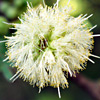Acacia raddiana is a short desert tree with an impressive umbrella shape: a single non-branched trunk, which at a certain height (1-3 meters) suddenly branches into a broad and flat crown. The bark is brown-reddish.
The tree grows deep roots. It grows in places where there is water at great depths and utilizes water stores that other plants cannot compete take advantage of. It is found mostly in the beds of seasonal streams in the desert. It grows in the Negev Desert and has also penetrated less dry and warm areas. It is prevalent in the suitable places, is prominent in the landscape and holds a dominant position in its ecosystem.
Acacia raddiana is very thorny. The thorns originate from stipules, and are sharp and rigid. Indeed, its young leaves need all possible protection in an environment where every green sprout is in great demand. Drivers know that they should not pass with their cars under Acacia trees, because the thorns of branches that fell can puncture tires. Nonetheless, the camel succeeds in sticking its lips between the thorns and biting the leaves. Gazelles feed on fallen fruits. Furthermore, its seeds will germinate better after they have passed through the gazelle’s stomach.
The tree belongs to the Mimosaceae family, Leguminosae. The young leaves and branches are glabrous.The leaves are alternate, bipinnate. There are several nectaries on the leaf axis.
Acacia raddiana blooms mainly from October to December, also in March-April. The flowers are light yellow, arranged densely in small globules, like other members of the genus. The filaments are long, protrude from the corolla and determine the color of the inflorescence. The fruit is a curled legumen.
The genus Acacia contains 750 species, half of which grow in Australia and the Pacific Ocean islands. In Israel there are 4 species that grow wild and several other domesticated species.
Written by Mike Livne






